|
|
 |
|
| Tantrix Glossary |
| BAG: | During the game, tiles are kept in a container called the bag and picked up at random. Players may count the number of tiles left in the bag without looking inside. | ||
| BLOCK: | A line is blocked when no tiles fit the space at its end. Blocks may be temporary or permanent. | ||

In the image on the right, Blue creates a forced space at A having counted that there are no yellow-green-red tiles left, thus blocking Red's line permanently. 
In the image on the left, the Yellow line is permanently blocked at B as it ends in a space with three yellow links. However, this is only legal during the endgame. |
|||
| CONTROLLED SIDE: | 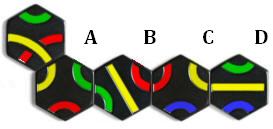
This image shows a controlled side. The third restriction rule forbids playing tiles along controlled sides. The forced space at A must be filled first, then B must be filled, then C etc. |
||
| DEADLOCK: | A game becomes deadlocked if a player has nowhere legal to play during their free move. In this case the game is drawn. However, deadlocks are very rare (about 1 in 10,000 games). | ||
|
DIRECT CONNECTION: |
 A line is said to be directly connected once all its indirect connections have been filled. In the image on the left, the three yellow links are directly connected and the three blue links are indirectly connected. |
||
| DOUBLES: | Tantrix Doubles is for 4-players (two teams of two). Each player takes a hand of 6 tiles as usual, but each team chooses a colour and partners sit opposite each other. The normal game rules apply. Team talk is definitely allowed! | ||
| ENDGAME: | The endgame begins when the last tile is drawn from the bag. The restrictions no longer apply, so it becomes easier to block the other players' lines. | ||
| FIT ANALYSIS: |
A tile fits a forced space if the three-colour sequence of the forced space matches with any three-colour sequence on the tile. Fits are classified into three types.
|
||
| FORCED LOOP: | 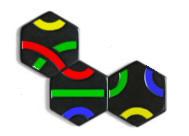 Force-looping is a good attacking tactic, particularly at the beginning of a game, as loops can never be enlarged! This image shows a green loop which will only scores 10 points after it is finished. |
||
| FORCED SPACE: | A space surrounded by three tiles is called a forced space. If possible, forced spaces must be filled immediately by the player whose turn it is. | ||
| FREE MOVE: | Each player has one free move per turn where they can place a tile of their choice in any legal position. However, players must also fill any forced spaces, both before and after their free move. | ||
| GOLDEN RULE: | All touching tiles must have matching coloured links. In other words, different colours are not allowed to touch. | ||
| HOLES: | Holes are empty spaces entirely surrounded by tiles. Prior to the endgame, holes cannot occur because of the restriction rules. However, during the endgame holes can be legally created. | ||
|
INDIRECT CONNECTION: |
 This image shows an indirectly connected blue line. The blue line is likely to connect at A and B, and currently has an indirect length of five. |
||
| LINE: | Any two or more links connected together form a line. The longest possible line is 42 tiles long, compared to the average line length of around 20. | ||
| LINKS: | There are three different link shapes: corners, straights and bends. A corner represents a 120-degree deviation in path, a bend 60 degrees and a straight 0 degrees. Any closed loop has a total of 360 degrees. To demonstrate this: Add up all the angles of links which curve TOWARDS the centre of the loop and subtract all the angles of links which turn AWAY from the centre of the loop. | ||
| LOOKALIKE: | 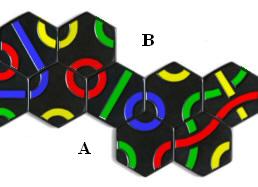 When a player is waiting for a specific tile to fill a forced space, the opponent may want to create a lookalike forced space. The image shows two identical forced spaces at (yellow-green-green). Whoever picks up a tile that fits can choose where to play it. |
||
| LOOP: | 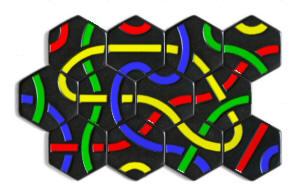 A line which curves back to join itself is called a loop and scores double points. This yellow loop has nine tiles, scoring eighteen points. |
||
| MIND GAME: | The earliest version of Tantrix was created in 1988 and called the 'Mind Game'. It consisted of and a hexagonal playing board and 56 tiles with links in only two colours. | ||
| PAIR: | 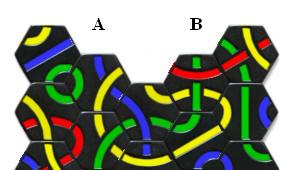 A pair is two links of the same colour on adjacent tiles along the edge of the Tantrix. Pairs can help create blocks. The combination of the blue block at A and the green block at B mean that of the 6 tiles that can fit the forced space only two will fit before the endgame (when restrictions are removed). |
||
|
RESTRICTION RULES: |
There are three types of move that are not allowed while tiles remain in the bag. These restriction rules do not apply during the endgame.
|
||
| SCORE: | A player's score is calculated by counting the number of tiles in their longest line or loop. Loops score double. The theoretical maximum score is 84 points from a loop of 42 tiles. However, the highest actual score recorded online is 74. The lowest winning score is nine points. A comprehensive database of records is maintained online at Tantrix.com. | ||
| STATISTICS: | In a set of 56 tiles there are:
|
||
| TANTRIX: | During play, 'the Tantrix' is used to refer to all tiles already played on the table. The name itself is derived from 'tangled tracks'. | ||
| TRIPLE INTERSECTION: |
The first edition of Tantrix consisted of 64 tiles, including eight 'triple intersection' (TI) tiles.
Because of their perfect bilateral symmetry, TI tiles only fit into three different types of forced spaces, all other tiles fit into 6. Consequently during a game,
TI tiles tended to accumulate in players' hands, thereby effectively reducing the number of useful tiles available to them. As a result of this “clogging”,
blocked games were more common.
For more information on triple intersections click here. |
||
| Home | Site Map | Products | Play Online | Buy Tantrix | About Us | Contact Us |
© Copyright 2017, Colour of Strategy Ltd, Pohara, New Zealand. All rights reserved. Last update: July, 2017 |